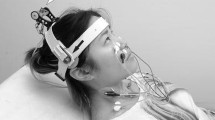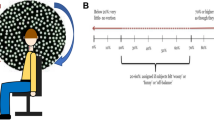Summary
Our laboratory at the Johnson Space Center has employed the H-reflex recorded from the soleus muscle as a method of monosynaptic reflex testing in conjunction with vertical linear acceleration to assess modification of utriculo-saccular function induced through prolonged exposure to microgravity. It was hypothesized that exposure to free fall would reduce the necessity for postural reflexes in the major leg muscles, and that postural modification would reflect a change, not in the peripheral vestibular organs, but more centrally. This postural adjustment would reflect a sensory motor rearrangement where otolith receptor input was reinterpreted to provide an environmentally appropriate response. In addition to the H-reflex (which was the only inflight measurement), vestibulo-spinal EMG from the gastrocnemius, and self-motion reports were obtained in response to a sudden earth vertical fall. Preflight, inflight and postflight motion sickness reports were also recorded, and related to the H-reflex data. The results indicated that early inflight H-reflex amplitude was similar to that recorded preflight, but that measurements obtained later in the flight (day seven) did not show a change in potentiation as a function of the different drop to shock intervals. Immediate postflight H-reflex response in three of the four astronauts tested showed a rebound effect. Postflight gastrocnemius EMG in response to the sudden fall did not show a significant change from preflight values. However, one crewman who was tested early postflight did show an increase in EMG activity in response to the sudden fall. This immediate postflight effect returned to baseline rapidly. Self-motion perception obtained inflight suggested that the early inflight drops were perceived like those preflight. Drops later inflight were described as sudden, fast, hard and translational in nature. Immediately postflight the drops were perceived like those late inflight, and the astronauts said that they did not feel as though they were falling, rather the floor came up to meet them. Post hoc peak H-reflex amplitude, both preflight and postflight was related to inflight space motion sickness.
Similar content being viewed by others
References
Baker JT, Nicogassian AE, Hoffler GW, Johnson RL, Hordinsky J (1977) Measurement of a single tendon reflex in conjunction with myogram: the second manned skylab mission. In: Biomedical results from skylab. NASA SP-377: p 131
Buchthal F, Schmalbruch H (1976) Contraction times of reflexly activated motor units and excitability cycle of the H-reflex. In: Homma S (ed) Understanding the stretch reflex. Prog Brain Res 44: 367–375
Clement G, Gurfinkel VS, Lestienne F (1985) Mechanisms of posture maintenance in weightlessness. Vestibular and visual control on posture and locomotor equilibrium. Igarashi and Black (eds), pp 158–163
Dunnett CW (1964) New tables for multiple comparisons with a control. Biometrics 20: 482–491
Gassel MM, Diamantopoulos E (1964) Pattern of conduction times in the distribution of the radial nerve. Neurology (Minneap) 14: 222–231
Gottlieb GL, Agarwal GC (1978) Stretch and Hoffmann reflexes during phasic voluntary contractions of the human soleus muscle. Electroenceph Clin Neurol 44: 553–561
Greenhouse SW, Geiser S (1959) On methods in the analysis of profile data. Psychometrika 24: 95–112
Greenwood RJ, Hopkins AP (1974) Muscle activity in falling man. J Physiol (Lond) 241: 26–27
Greenwood RJ, Hopkins AP (1976a) Landing from an unexpected fall and a volunteer step. Brain 99: 375–386
Greenwood RJ, Hopkins AP (1976b) Muscle responses during sudden falls in man. J Physiol (Lond) 254: 507–518
Greenwood RJ, Hopkins AP (1977) Monosynaptic reflexes in falling man. Neurol Neurosurg Psychiat 40: 448–454
Gualtierotti T (1972) Orbiting frog otolith experiment: (OFO-AO). Final report on the data reduction and central experimentation, NASA-Contract NASW-2211. Piccin Medical Books: prepared by University of Milan
Hoehler FK, McCann MA, Bernick DL (1981) Habituation of the Hoffmann reflex. Brain Res 220: 299–307
Hoffmann P (1918) Über die Beziehungen der Sehnenreflexe zur willkürlichen Bewegung und zum Tonus. Z Biol 68: 351–356
Hoffmann P (1922) Untersuchungen über die Eigenreflexe (Sehnenreflexe) menschlicher Muskeln. Springer, Berlin
Homick JL, Reschke MF (1977) Postural equilibrium following exposure to weightless space flight. Acta Oto-Laryngol 83: 455–464
Homick JL, Reschke MF, Vanderploeg JM (1984) Space adaptation syndrome: incidence and operational implications for the space transportation system program. In: Motion sickness: mechanisms, prediction, prevention and treatment. North Atlantic Treaty Organization, Neuilly-sur-Seine, France, pp36.1–36.6
Hugon M (1973) Methodology of the Hoffman reflex in man. In: Desmedt JE (ed) New development in electromyography and chemical neurophysiology, Vol 3, pp 277–293
Kozlovskaya IB, Kreidich YuV, Rakham OV (1981) Mechanisms of the effects of weightlessness on the motor system of man. Physiologist Suppl 24: 59–64
Kozlovskaya IB, Aslanova IF, Grigorieva LS, Kreidich YuV (1982) Experimental analysis of motor effects of weightlessness. Physiologist Suppl 25: 49–52
Kozlovskaya IB, Aslanova IF, Barmin VA, Grigorieva LS, Gevlich GI, Kirenskaya AV, Sirota MG (1983) The nature and characteristics of a gravitational ataxia. Physiologist Suppl 26: 108–109
Lackner JR (1978) Some mechanisms underlying sensory and postural stability in man. In: Held R, Leibowitz HW, Teuber HL (eds) Handbook of sensory physiology, Vol 3, pp 806–845
Lin KK (1983) Statistical models for 4-factor experiments with repeated measures. A technical report, Life Sciences Division, Technology Incorporated, Houston, Texas
Magladery JW (1955) Some observations on spinal reflexes in man. Pflügers Arch Ges Physiol 261: 302–321
Matthews Sir Bryan, Whiteside TCD (1960) Tendon reflexes in free fall. Proc R Soc B 153: 195–204
Melvill Jones G, Watt DGD (1971) Muscular control of landing from unexpected falls in man. J Physiol 219: 729–737
Melvill Jones G (1974) Adaptive neurobiology in space flight. The Proceedings of the Skylab Life Science Symposium, Vol 2, NASA TM X-58154. Houston:National Aeronautics and Space Administration, pp 847–860
Oman CM (1982) Space motion sickness and the vestibular experiments in Skylab. Twelfth Intersociety Conference on Environmental Systems, Society of Automotive Engineers, San Diego
Oman CM, Lichtenberg BK, Money KE (1984) Space motion sickness monitoring experiment: spacelab 1. In: Motion sickness: mechanisms, prediction, prevention and treatment. North Atlantic Treaty Organization, Neuilly-sur-Seine, France, pp 35.1–35.21
Parker DE, Reschke MF, Arrott AP, Homick JL, Lichtenberg BK (1984) Preliminary DSO 0433 Summary Report for STS-11(41-B). National Aeronautics and Space Administration, Houston
Parker DE, Reschke MF, Arrott AP, Homick JL, Lichtenberg BK (1983) DSO 0433 Summary Report for STS-8. National Aeronautics and Space Administration, Houston
Parker DE, Reschke MF, Arrott AP, Homick JL, Lichtenberg BK (1985) Otolith tilt-translation reinterpretation following prolonged weightlessness: implications for preflight training. Aviat Space Env Med 56: 601–606
Reschke MF, Anderson DJ, Homick JL (1984a) Vestibulospinal reflexes as a function of microgravity. Science 225: 212–213
Reschke MF, Parker DE, Homick JL, Anderson DJ, Arrott AP, Lichtenberg BK (1984b) Reinterpretation of otolith input as a primary factor in space motion sickness. In: NATO/AGARD Aerospace Medical Panel Symposium: Results of Space Experiments in Physiology and Medicine. Istanbul, Turkey, pp 3–1 to 3–18
Reschke MF (1985b) Unpublished data from Spacelab-3
Reschke MF, Anderson DJ, Moore M, Homick JL (1976) Vestibulo-spinal responses as a function of zero-g. Soc Neurosci Abstr 2: 1061
Reschke MF, Homick JL, Anderson DJ (1985a) Development of vestibulospinal reflex measurements as a method for the investigation of statotolith function during sustained weightlessness. Vestibular and visual control on posture and locomotor equilibrium. Igarashi and Black (eds), pp 151–157
Reschke MF, Homick JL, Baker JT (1979) Vestibulo-spinal reflexes in man as a function of linear acceleration. Aerospace Med Assoc Abstr, pp 298–299
Táboříková H (1973) Supraspinal influences on H-reflexes. In: Desmedt JE (ed) New development in electromyography and clinical neurophysiology, Vol 3, pp 328–336
Táboříková H, Provini L, Decandia M (1966) Evidence that muscle stretch evokes long-loop reflexes from higher centers. Brain Res 2: 188–192
Tanaka R (1976) Reciprocal Ia inhibition and voluntary movements in man. Understanding the stretch reflex. Homma S (ed). Prog Brain Res 44: 291–301
Thornton WE (1983) Report of STS-8 Biomedical DSO Results. Presentation to USRA Space Adaptation Working Panel. Unpublished data. Johnson Space Center, Houston, Texas
Vorokyov Yel, Gazenko OG, Genin AM, Egorov AD (1982) Basic medical results of the latest USSR space flights. Thirtythird Congress of the International Astronautical Federation, pp 2–5
Watt DGD (1976) Responses of cats to sudden falls: an otolithoriginating reflex assisting landing. J Neurophysiol 39: 257–264
Watt DGD (1981) Effect of vertical linear acceleration on H-reflex in decerebrate cat I.Transient stimuli. J Neurophysiol 45: 644–655
Winer BJ (1971) Statistical principles in experimental designs, 2nd edn. McGraw-Hill, New York, pp 201–204, 539–559
Young LR, Oman CM, Watt DGD, Money KE, Lichtenberg BK (1984) Spatial orientation in weightlessness and readaptation to earth's gravity. Science 225: 205–208
Author information
Authors and Affiliations
Rights and permissions
About this article
Cite this article
Reschke, M.F., Anderson, D.J. & Homick, J.L. Vestibulo-spinal response modification as determined with the H-reflex during the Spacelab-1 flight. Exp Brain Res 64, 367–379 (1986). https://doi.org/10.1007/BF00237753
Received:
Accepted:
Issue Date:
DOI: https://doi.org/10.1007/BF00237753




